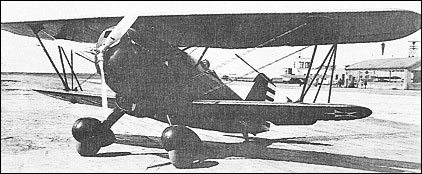|
| In 1931, the third production P-6 (which had been converted
to P-6A standard) was withdrawn from service
and returned to Curtiss for extensive modification as
the XP-22. Retaining the V-1570-23 engine, the XP-22
was cleaned up aerodynamically and featured cantilever
main undercarriage legs and wheel spats, plus a
redesigned engine cowling with, initially, an annular
radiator. The radiator was subsequently returned to a
position beneath the rear of the engine. On 30 June
1931, the XP-22 demonstrated a level speed of
326km/h and on 10 July a USAAC contract
was placed for 45 Y1P-22s. These were subsequently
redesignated as P-6Cs, but prior to the start of production
deliveries the designation was changed once more
to P-6E. By this time, the engine of the XP-22, complete
with cowling and three-blade propeller, plus the main
undercarriage members, had been grafted on to the
YP-20, which had thus become the XP-6E, while the
XP-22 was returned to P-6A configuration.
| WEIGHTS |
| Take-off weight | 1521 kg | 3353 lb |
| Empty weight | 1178 kg | 2597 lb |
| DIMENSIONS |
| Wingspan | 9.60 m | 32 ft 6 in |
| Length | 7.19 m | 24 ft 7 in |
| Height | 2.69 m | 9 ft 10 in |
| Wing area | 23.41 m2 | 251.98 sq ft |
| PERFORMANCE |
| Max. speed | 325 km/h | 202 mph |
| Dick Sager, e-mail, 13.12.2011 18:01 Possibly the best looking biplane ever produced. reply |
|
Do you have any comments?
|
| 
COMPANY
PROFILE
All the World's Rotorcraft
|






